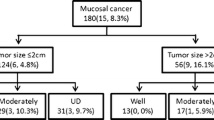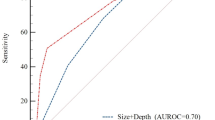Abstract
Background
Previous studies report that 5.9–22.2% of patients with preoperatively diagnosed early gastric cancers were eventually proven to have advanced gastric cancers by postoperative pathological examination. Such misdiagnosed cases commonly had cancers with macroscopic appearance like early gastric cancer and consequently can be recognized as a subgroup of cancer, namely advanced gastric cancer with early cancer macroscopic appearance (eAGC). Theoretically eAGCs might require D2 lymphadenectomy, but frequently undergo limited lymphadenectomy. However, the validity of the limited surgery is still unclear.
Methods
Clinicopathologic features of 134 patients with eAGC were retrospectively reviewed and compared with those of patients with early gastric cancers and advanced gastric cancers, respectively.
Results
Clinicopathologic features of eAGCs were similar to those of submucosa cancers, but significantly different from those of mucosa cancers and other muscularis propria cancers. Tumor size, lymphatic and/or blood vessels invasion (LBVI), and depth of invasion were identified as independent factors predicting lymph node metastasis; however, postoperative stage was not. All patients with eAGCs were proven to have lymph node metastasis restricted to the perigastric lymph nodes and lymph nodes at stations 7, 8a, and 9. Age, LBVI, and depth of invasion were independent prognostic factors for patients with preoperatively diagnosed early gastric cancers; however, the misdiagnosis of early cancer and the option of lymphadenectomy (D2 or not D2) had no impact on patient survival. The incidence of recurrence of eAGCs was similar to that of submucosa cancers, but significantly different from that of mucosa cancers and other muscularis propria cancers.
Conclusions
Modified gastrectomy B (dissection of perigastric lymph nodes and nodes at stations 7, 8a, and 9) might be recommended for patients with eAGCs.




Similar content being viewed by others
References
Jemal A, Siegel R, Ward E, et al. Cancer statistics, 2008. CA Cancer J Clin. 2008;58:71–96.
Goggins WB, Wong GK. Poor survival for US Pacific Islander cancer patients: evidence from the Surveillance, Epidemiology, and End Results database: 1991 to 2004. J Clin Oncol. 2007;25:5738–41.
Crew KD, Neugut AI. Epidemiology of gastric cancer. World J Gastroenterol. 2006;12:354–62.
Katai H, Sano T. Early gastric cancer: concepts, diagnosis, and management. Int J Clin Oncol. 2005;10:375–83.
Lee SE, Lee JH, Ryu KW, et al. Sentinel node mapping and skip metastases in patients with early gastric cancer. Ann Surg Oncol. 2009;16:603–8.
Kwee RM, Kwee TC. Predicting lymph node status in early gastric cancer. Gastric Cancer. 2008;11:134–48.
Lo SS, Wu CW, Chen JH, et al. Surgical results of early gastric cancer and proposing a treatment strategy. Ann Surg Oncol. 2007;14:340–7.
Nakajima T. Gastric cancer treatment guidelines in Japan. Gastric Cancer. 2002;5:1–5.
Sano T, Okuyama Y, Kobori O, et al. Early gastric cancer. Endoscopic diagnosis of depth of invasion. Dig Dis Sci. 1990;35:1340–4.
Kwee RM, Kwee TC. Imaging in local staging of gastric cancer: A systematic review. J Clin Oncol 2007;25:2107–16.
Namieno T, Koito K, Hiigashi T, et al. Endoscopic prediction of tumor depth of gastric carcinoma for assessing the indication of its limited resection. Oncol Rep. 2000;7:57–61.
Saito N, Takeshita K, Habu H, et al. The use of endoscopic ultrasound in determining the depth of cancer invasion in patients with gastric cancer. Surg Endosc. 1991;5:14–9.
Ganpathi IS, So JB, Ho KY. Endoscopic ultrasonography for gastric cancer: Does it influence treatment? Surg Endosc. 2006;20:559–62.
Shimizu K, Ito K, Matsunaga N, et al. Diagnosis of gastric cancer with MDCT using the water-filling method and multiplanar reconstruction: CT-histologic correlation. Am J Roentgenol. 2005;185:1152–8.
Cristallini EG, Paganelli C, Ascani S, et al. Endoscopic and histological criteria for preoperative evaluation of the depth of infiltration of gastric carcinoma. Surg Endosc. 1994;8:1305–7.
Seto Y, Shimoyama S, Kitayama J, et al. Lymph node metastasis and preoperative diagnosis of depth of invasion in early gastric cancer. Gastric Cancer. 2001;4:34–8.
Schwarz RE, Zagala-Nevarez K. Recurrence patterns after radical gastrectomy for gastric cancer: prognostic factors and implications for postoperative adjuvant therapy. Ann Surg Oncol. 2002;9(4):394–400.
D’Angelica M, Gonen M, Brennan MF, et al. Patterns of initial recurrence in completely resected gastric adenocarcinoma. Ann Surg. 2004;240(5):808–16.
Sarela AI, Turnbull AD, Coit DG, et al. Accurate lymph node staging is of greater prognostic importance than subclassification of the T2 category for gastric adenocarcinoma. Ann Surg Oncol 2003;10:783–91.
Komatsu S, Ichikawa D, Kurioka H, et al. Prognostic and clinical evaluation of patients with T2 gastric cancer. Hepatogastroenterology. 2005;52:965–8.
Okuno K, Shigeoka H, Tanaka A, et al. Clinicopathological evaluation of T2-gastric cancer among age groups. Hepatogastroenterology. 2000;47:1180–2.
Isozaki H, Fujii K, Nomura E, et al. Prognostic factors of advanced gastric carci-noma without serosal invasion (pT2 gastric carcinoma). Hepatogastroenterology. 1999;46:2669–72.
Park do J, Kong SH, Lee HJ, et al. Subclassification of pT2 gastric adenocarcinoma according to depth of invasion (pT2a vs. pT2b) and lymph node status (pN). Surgery. 2007;141:757–63.
Nitti D, Marchet A, Mocellin S, et al. Prognostic value of subclassification of T2 tumours in patients with gastric cancer. Br J Surg. 2009;96:398–404.
Yamashita K, Sakuramoto S, Kikuchi S, Katada N, Kobayashi N, Watanabe M. Validation of staging systems for gastric cancer. Gastric Cancer. 2008;11(2):111–8.
Sun Z, Zhu GL, Lu C, et al. A novel subclassification of pT2 gastric cancers according to the depth of muscularis propria invasion: superficial muscularis propria versus deep muscularis propria/subserosa. Ann Surg. 2009;249:768–75.
Sakuramoto S, Sasako M, Yamaguchi T, et al. Adjuvant chemotherapy for gastric cancer with S-1, an oral fluoropyrimidine. N Engl J Med. 2007;357:1810–20.
Cunningham D, Allum WH, Stenning SP, et al. Perioperative chemotherapy versus surgery alone for resectable gastroesophageal cancer. N Engl J Med. 2006;355:11–20.
Nakajima T, Nashimoto A, Kitamura M, et al. Adjuvant mitomycin and fluorouracil followed by oral uracil plus tegafur in serosa-negative gastric cancer: a randomized trial. Gastric Cancer Surgical Study Group. Lancet. 1999;354:273–7.
Nashimoto A, Nakajima T, Furukawa H, et al. Randomized trial of adjuvant chemotherapy with mitomycin, fluorouracil, and cytosine arabinoside followed by oral fluorouracil in serosa-negative gastric cancer: Japan Clinical Oncology Group 9206-1. J Clin Oncol. 2003;21:2282–7.
Acknowledgment
Supported by grants from the National Natural Science Foundation of China (no. 30901419).
Author information
Authors and Affiliations
Corresponding author
Rights and permissions
About this article
Cite this article
Sun, Z., Wang, Zn., Zhu, Gl. et al. Advanced Gastric Cancer with Early Cancer Macroscopic Appearance: Is It Worthy of D2 Lymphadenectomy?. Ann Surg Oncol 17, 1278–1290 (2010). https://doi.org/10.1245/s10434-009-0890-x
Received:
Published:
Issue Date:
DOI: https://doi.org/10.1245/s10434-009-0890-x




